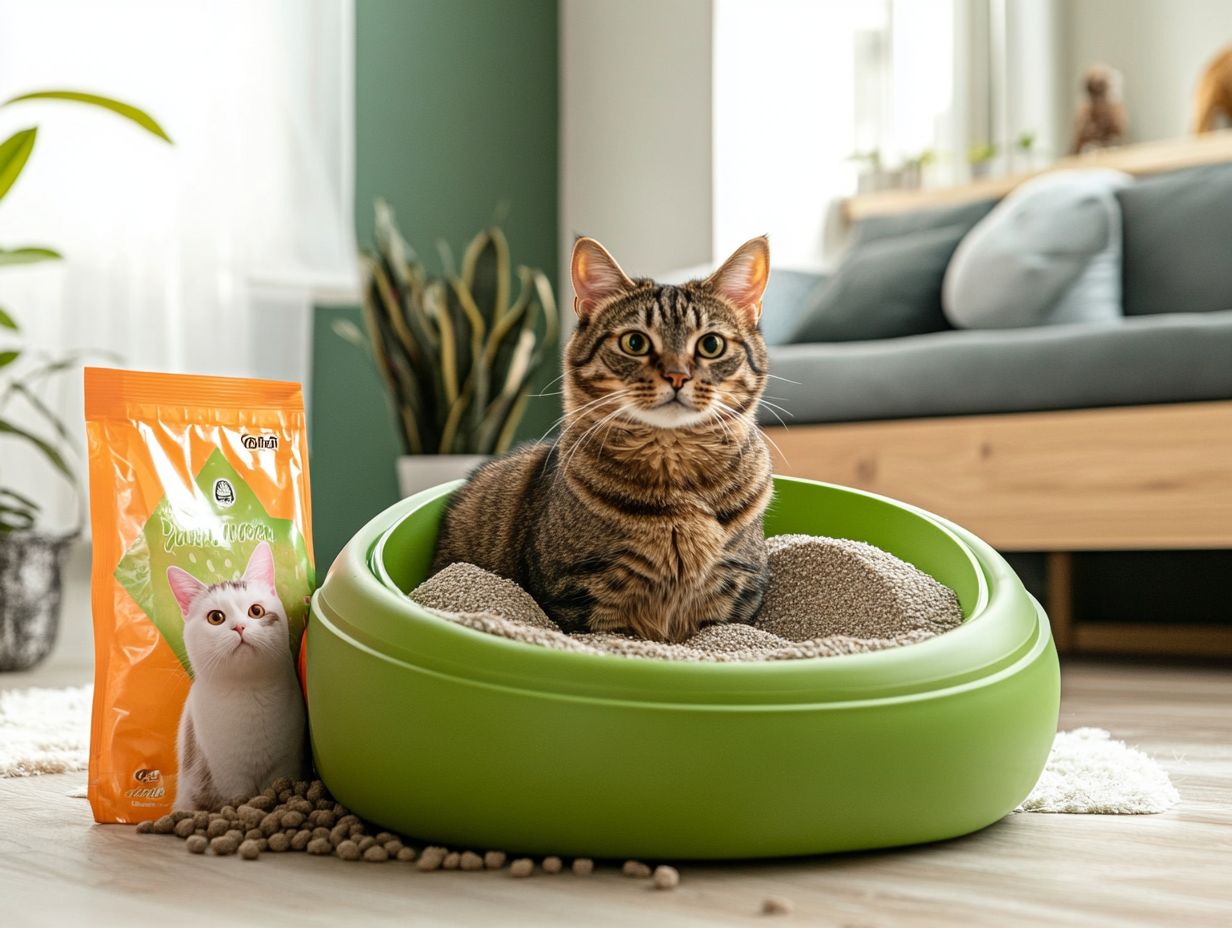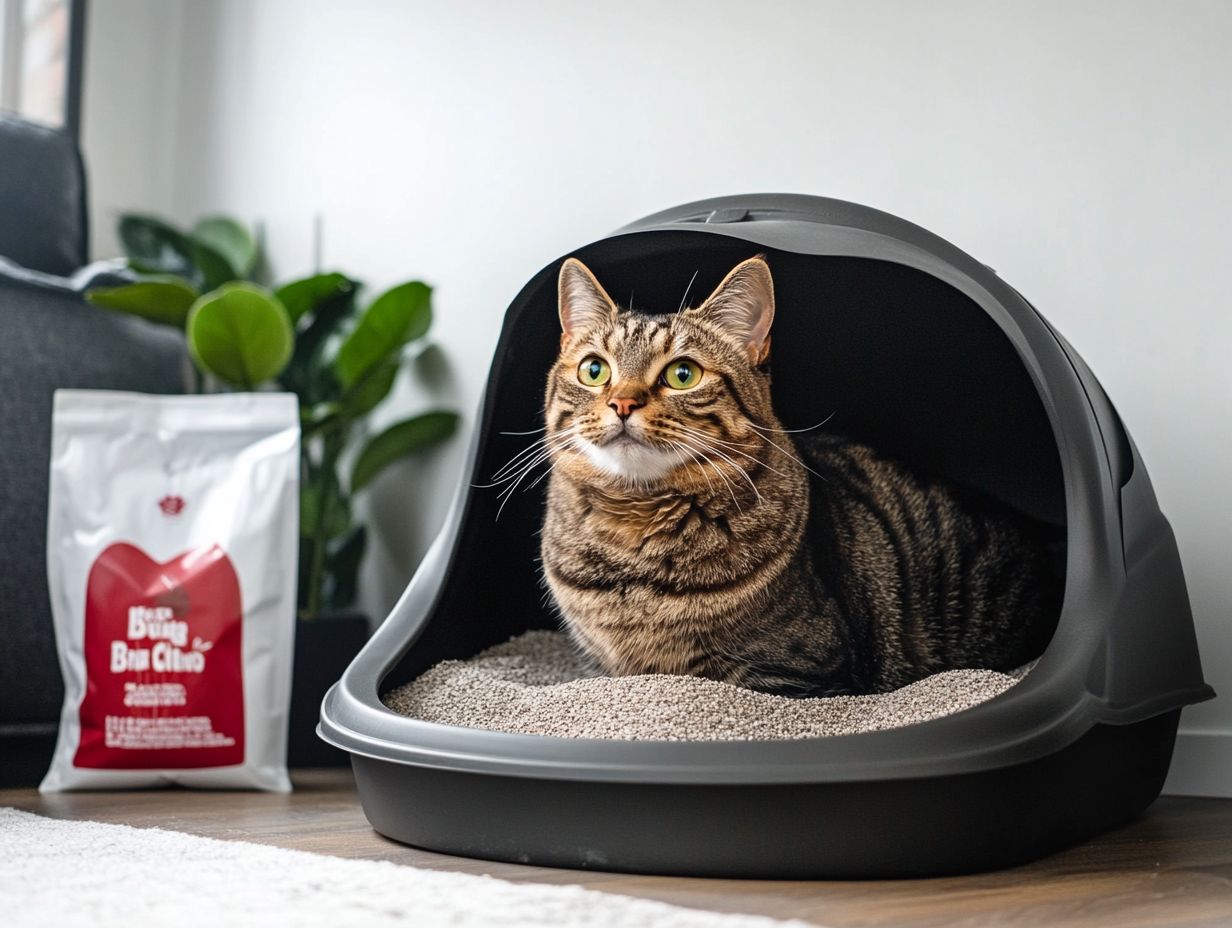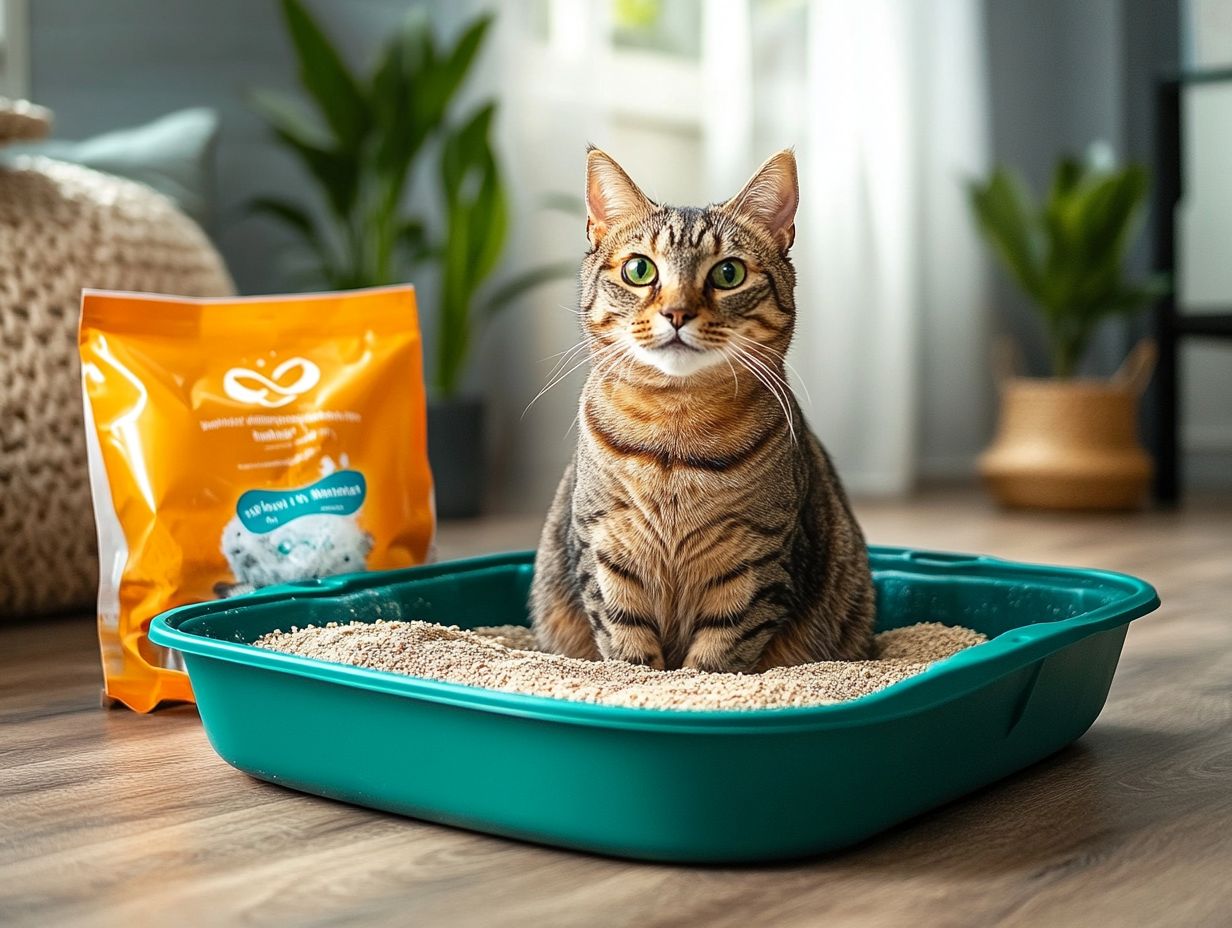Choosing the right litter box for your large feline friend is essential for their comfort and your home’s cleanliness. The right litter box accommodates your cat’s size and behavior, making it easier for both of you.
Extra large cat litter boxes provide ample space for breeds like the Ragdoll, allowing them to use the box comfortably while helping maintain a tidy, odor-free home.
This article reviews the top five extra-large litter boxes on the market, shares tips to encourage your cat to use them, and provides essential cleaning and maintenance advice to keep everything in top shape using recommended cleaning tools.
Key Takeaways:

- Invest in a high-sided or hooded litter box for your large cat’s comfort, considering features like high back walls and comfortable entry points.
- Gradually introduce the new litter box to your cat, utilizing a litter mat to minimize scattered litter, and keep it clean to encourage usage.
- Use appropriate cleaning products, scoop daily, and perform deep cleaning weekly to effectively maintain an extra large litter box.
Choosing the Right Litter Box
Large cats require extra-large litter boxes that are both tall and spacious to create an efficient litter environment. Selecting the right extra-large cat litter box, such as the Petmate Giant or the Frisco High-Sided Litter Box XL, can help minimize litter scatter and tracking while ensuring easy entry and convenient cleaning.
This article reviews the five best extra-large cat litter boxes available today, highlighting their key features, materials, and how they cater to the needs of large breeds like the Maine Coon and Savannah cat.
Benefits and Drawbacks of Litter Box Types
High-sided litter boxes effectively contain litter mess and are particularly suited for cats that dig or kick litter. However, they may not provide the privacy some cats prefer. In contrast, hooded litter boxes can offer enhanced odor control and privacy, but they may limit the space for larger cats.
Expert opinions suggest that the best choice depends on your cat’s behavior and preferences. Observing your cat’s litter box habits can provide insights into which type will suit them best.
Common Litter Box Problems and Solutions
One common issue is cats peeing outside the litter box. This behavior can stem from litter box aversion, often caused by the box being too small, dirty, or poorly placed. To address this, provide a clean, appropriately sized box and consider placing it in a quiet, accessible area. Consult with your veterinarian if problems persist.
Litter Maintenance Tips
Maintaining a clean litter box is crucial for your cat’s health. Regular scooping and deep cleaning help prevent odors and contamination.
Top 5 Extra Large Cat Litter Boxes
1. Giant High-Sided Litter Box
The Petmate Giant High-Sided Litter Box features very high sides that effectively contain litter mess, making it suitable for large cats. Its spacious design provides ample room for even the largest cats to move comfortably, allowing them to feel secure.
The elevated walls help minimize litter scatter, and the durable plastic construction allows for easy cleaning and longevity.
2. Jumbo Hooded Litter Pan
The Catit Jumbo Hooded Litter Pan is a spacious litter box designed for effective odor control, providing ample room for larger cats. Its high walls minimize litter scattering, while the hood offers added privacy and enhanced odor control.
The unique design simplifies cleaning and reduces mess during maintenance, making it a practical option for pet owners.
3. Extra Large Self-Cleaning Litter Box
The Extra Large Self-Cleaning Litter Box utilizes technology to maintain cleanliness with minimal effort. It features a smart sensor that detects when the cat has used it and initiates a self-cleaning cycle.
Constructed from non-porous, durable materials, this litter box resists odors and is easy to wipe down, promoting better pet health by reducing contamination risks.
4. Top-Entry Litter Box for Large Cats

Top-entry litter boxes for large cats minimize litter tracking while ensuring your pet can comfortably use the box. The covered top-entry design prevents litter particles from spreading throughout your home and enhances odor control.
Conclusion
Choosing the right litter box is vital for the comfort of your large cat and the cleanliness of your home. Evaluate your current litter box setup and consider the options discussed in this article to find the best fit for your feline friend.
Built to accommodate larger breeds, these boxes utilize sturdy materials and include unique features like anti-microbial protection to help keep the litter box clean and odor-free. This combination of functionality and hygiene makes top-entry litter boxes for large cats a practical solution for cat owners. Consult reputable veterinary sources to verify the benefits of anti-microbial protection and its role in odor control.
5. Extra Large Corner Litter Box
The Extra Large Corner Litter Box is an excellent choice for cat owners who want to maximize space while providing an ideal environment for larger cats. Its unique design utilizes often-overlooked corners in homes, allowing it to blend seamlessly with various interior styles.
Measuring approximately 30 inches on each side—roughly the average size for large breeds like Maine Coons or Ragdolls—it offers ample space for large breeds while occupying a smaller footprint. Many users report that their pets appreciate the extra room to move around, reducing stress since larger boxes allow cats to turn around comfortably.
Additionally, its accessibility and ease of cleaning enhance the overall experience, making it a superb option for those in tight living spaces who do not want to compromise their pets’ comfort.
How to Encourage Your Cat to Use an Extra Large Litter Box?
Encouraging your cat to use an extra-large litter box can be challenging for some owners. However, with the right methods and proper litter box configuration, the transition can be made easier and more comfortable for your pet.
1. Gradually Introduce the New Litter Box
Gradually introducing a new litter box can help ease your cat’s transition and encourage confident use. Start by placing the new box in a familiar area where your cat frequently spends time and knows how to access.
Keeping the old litter box in place for a while can provide additional comfort and security during this adjustment period. Research on cat behavior suggests that allowing pets to approach the new box at their own pace reduces stress and fosters exploration.
Additionally, using litter that closely resembles their current one can further facilitate the transition, making the entire process more effective.
It’s typically recommended to have one litter box per cat, plus one extra, to ensure that your cat feels comfortable with their options.
2. Keep the Litter Box Clean
Regularly cleaning the litter box encourages cats to use it, as they dislike dirty spaces. Cats are inherently hygienic animals and naturally prefer clean environments.
Daily maintenance—scooping out soiled litter and replacing it with fresh litter—significantly increases the likelihood that cats will use the litter box rather than eliminate in other areas. Conversely, if owners neglect to clean the litter box consistently, cats may develop behavioral issues, leading them to avoid the litter box and urinate elsewhere.
Consider the type of litter used; clumping litter can make it easier to keep the box clean, while non-clumping options may require more frequent changes.
3. Consider Adding a Litter Box Attractant

Using a litter box attractant can significantly increase the likelihood of your cat using a new extra-large litter box, especially if they are initially reluctant. These products are specifically designed to appeal to a cat’s natural instincts and preferences, often mimicking scents and textures reminiscent of appealing environments found in nature.
For instance, herbal essences in products like CatAttract or Dr. Elsey’s Cat Attract can enhance the attractiveness of the litter box. Scientific studies and expert recommendations support their effectiveness. To use these products, simply sprinkle a small amount on top of the existing litter or mix it in.
How to Properly Clean and Maintain an Extra Large Litter Box?
Cleaning and maintaining an extra-large litter box is essential for providing a hygienic environment for your cat, with consideration for durable, non-stick coatings.
This practice also helps minimize odors, reduce litter mess, and prolong the life of the box.
1. Use the Right Cleaning Products
Using appropriate cleaning products for your extra-large litter box is essential to maintain a healthy environment and ensure the safety of your cat.
Several cleaning solutions offer both cleaning and antimicrobial properties, including products with enzymes or those specifically formulated for pet areas. These solutions are effective at eliminating odors and bacteria.
It is crucial to follow the manufacturer’s instructions when using these cleaning products to achieve the desired results while keeping the solution safe for both you and your cat. Daily scooping is recommended, with a thorough deep clean at least once a week to maintain hygiene.
Lastly, not all cats are the same; some may prefer different types of litter or box styles. Observing individual cat behavior is essential for ensuring their comfort and satisfaction.
In summary, maintaining a clean and properly managed litter box is crucial for your cat’s well-being. Employing the right techniques not only encourages usage but also promotes a hygienic and stress-free environment.
Additionally, ventilating the area can help prevent the cleaning solution’s scent from becoming overpowering. Regular use of these products will create a healthier atmosphere for your pet, allowing them to thrive.
2. Scoop Daily and Change Litter Regularly
Daily scooping and regular litter changes are essential for maintaining the litter box, significantly affecting your cat’s willingness to use it. Establishing a consistent cleaning routine helps ensure that your feline friend remains comfortable and willingly uses their designated space.
It is advisable to scoop the litter at least once a day, preferably after meals or during times when your cat is most active. Additionally, a complete litter change should be performed every week or two, depending on the type of litter used. According to veterinary sources, maintaining a clean litter box can prevent issues such as urinary infections and litter box aversion.
This diligence not only promotes a healthier environment for your pet but also prevents unpleasant odors and potential health issues. Neglecting this aspect may lead to an aversion to the litter box, resulting in unwanted accidents around the house. For optimal placement, ensure the litter box is situated away from noisy appliances and high-traffic areas.
3. Deep Clean the Litter Box Weekly
Deep cleaning your extra-large litter box on a weekly basis is essential for eliminating accumulated odors and bacteria, ensuring your cat has a fresh environment with ample space to relieve itself. Make sure to scrub all surfaces thoroughly, not just the bottom.
Using warm water and unscented soap, along with a non-toxic disinfectant, will effectively remove dirt and grime, making it easy to clean. To further combat odors, consider sprinkling some baking soda during your cleaning routine. When scrubbing, be gentle to avoid scratching the durable materials, as this can lead to deterioration.
A clean litter box not only promotes your cat’s health and well-being but also minimizes odors in your home. It encourages your pet to use the box regularly, reducing the likelihood of behavioral issues. Additionally, a clean litter box positively impacts your own health and well-being.
4. Replace the Litter Box When Needed

Knowing when to replace your extra-large litter box is crucial for maintaining a healthy litter environment, as wear and tear can lead to hygiene issues, especially in multi-cat households.
Many signs indicating the need for a replacement are similar to those for changing the litter. For instance, visibly cracked or broken plastic can compromise the box’s structural integrity and create a breeding ground for bacteria, affecting cat behavior. Additionally, persistent odors that linger after normal cleaning suggest that the material has absorbed too much liquid, potentially posing a risk to your pet’s health.
To ensure your pet’s needs are met over time, it is advisable to select a new litter box made from high-quality materials like BPA-free plastic that are resistant to scratches and easy to clean.
Frequently Asked Questions
What are the best options for extra-large cat litter boxes for large cats like Maine Coons or Ragdolls?
Some of the best options for extra-large cat litter boxes for big cats include the Petmate Giant Litter Pan, Frisco High-Sided Litter Box XL, and the PetFusion BetterBox.
What size should an extra-large cat litter box be?
An extra-large cat litter box should be at least 20 inches long, 15 inches wide, and 16 inches high. This allows enough space for big cats to comfortably use the litter box. Consider providing visual examples or diagrams showing recommended sizes.
Why do big cats need extra-large litter boxes?
Large cats need extra-large litter boxes because they require more space to move around and dig in the litter, ensuring comfortable access. Smaller litter boxes can be uncomfortable for big cats and may lead to litter box aversion.
Can I use a regular-sized litter box for my big cat?
While you can use a regular-sized litter box for your big cat, it is not recommended. Big cats require more space to comfortably use the litter box and may develop issues with using a smaller litter box.
Are there any special features to look for in extra-large cat litter boxes for big cats?
Some special features to look for in extra-large cat litter boxes for big cats include high sides, a covered design, and easy access for cleaning. These features can help contain litter scatter and provide privacy for your cat.
Do I need to use a specific type of litter for extra-large cat litter boxes?
When choosing litter, consider the pros and cons of various types:
- Clumping vs. Non-Clumping: Clumping litter is easier to scoop; non-clumping absorbs moisture better.
- Clay vs. Natural: Clay is absorbent and controls odors; natural litters are often biodegradable.
By understanding these options, you can make informed choices that best suit your cat’s needs.
Conclusion
In summary, maintaining your cat’s litter box involves regular scooping, deep cleaning, and timely replacements. By implementing these practices, you ensure a healthier environment for your pet and reduce the risk of health issues. Consider this checklist for litter box maintenance:
- Scoop daily and change litter weekly.
- Deep clean thoroughly every week.
- Replace the litter box when signs of wear appear.
- Ensure proper placement for comfort.
- Choose the right litter type.
Following these steps will not only keep your home odor-free but also promote your cat’s overall well-being.
While there is no specific litter type required for extra-large cat litter boxes, it is essential to choose a litter that suits your cat’s preferences and the dimensions of the larger box. Consider factors like texture and scent, as some cats may prefer finer litter or unscented options.
Popular options include clumping clay litter, which offers excellent odor control and easy cleanup, and biodegradable litter, which is more environmentally friendly but may require more frequent changes. Experiment with different types of litter to find what your cat prefers, as this can help encourage consistent use of the litter box.
A general guideline is to have one litter box per cat, plus one extra, to ensure that each cat has access to a clean box. Regularly scoop the litter box daily and perform a complete clean at least once a week to prevent odors and ensure your cat’s comfort. For the best cat litter for extra-large boxes, keep these cat litter box maintenance tips in mind!